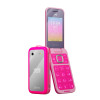Review: BlackBerry Bold 9900
The Bold 9900 runs BlackBerry 7, which is a refreshed version of RIM's system software. There are tweaks aplenty compared to what was available in BlackBerry 6, but they are barely noticeable. The home page has a number of different elements with which to interact. From top to bottom, the basic home screen has the status bar, the notification bar, main screen/wallpaper, and the app tray.
The status bar — where the clock, signal indicator, battery meter, etc. are located — is the top-most element. Press the time at the top from the home screen, and it opens up a tray of tools, such as network controls (WI-Fi, etc.), the alarm clock, and other basic settings. This feature doesn't work from other screens, only on the home screen.
The notification bar acts similarly to the drop-down notification shade in Android. Tapping it lets users quickly get a look at all of the unread messages they may have received. This includes email, SMS, MMS, BBM, Twitter replies/DMs, and Facebook notifications. You can see the first handful of each message type, and view info such as the sender and subject. Want to hide all the notifications? Tap the bar again and it goes away. If you do want to read a message, select it and the notification app will open the message in whichever messaging service it belongs to.
The app tray is where users will really be able to customize BlackBerry OS 7 handsets. The tray offers five different user-configurable home screens / menus. The first (and default) screen lists all the apps. The second lists those used most frequently. The third shows all downloads. The fourth is reserved for media. And the fifth is for user-chosen favorites. When the app tray is open users can swipe sideways between these five different home screens.
The Universal Search tool has been updated, though it behaves mostly as it did in BlackBerry 6. For example, if I type "Phone Scoop" while on the home screen, the Universal Search pulls up all the relevant items on the 9900 and delivers them to the desktop. This includes contacts, web sites, and so on. Do the same thing for quick access to a contact, or song, or any other application that you don't want to peck through the menus to find. If what you're looking for isn't on the phone, it offers web-based tools (YouTube, BlackBerry Maps, etc.) to continue searching.
Press-and-hold gestures can be used to open secondary menus in some applications. For example, in the contact application, the press-and-hold gesture conjures up the options menu, offering shortcuts to calling, texting, emailing, editing the contact and other actions. Use press-and-hold on the home screen, however, and the options will include moving, opening, deleting, or hiding the selected app, among other actions.
The real improvement doesn't come so much from BlackBerry 7 but from the fact that the 9900 is a touch phone. Being able to reach up with your thumb and select menu items instead of using the trackpad saves gobs and gobs of time.
Oddly, I noticed some hiccups with the 9900's performance. Mostly it was failure of the screen to register presses. Attempting to open the main app tray, for example, often took two or three presses on the screen. I can't say if this is due to a faulty display or faulty software, though the 9900's software wasn't slow to respond anywhere else.








 AT&T and RIM Announce 4G BlackBerry Lineup
AT&T and RIM Announce 4G BlackBerry Lineup
 New BlackBerry Bolds Add Touch, NFC, Run OS 7
New BlackBerry Bolds Add Touch, NFC, Run OS 7
 HMD Launches Barbie Phone in US
HMD Launches Barbie Phone in US
 BlackBerry Bold 9900
BlackBerry Bold 9900










